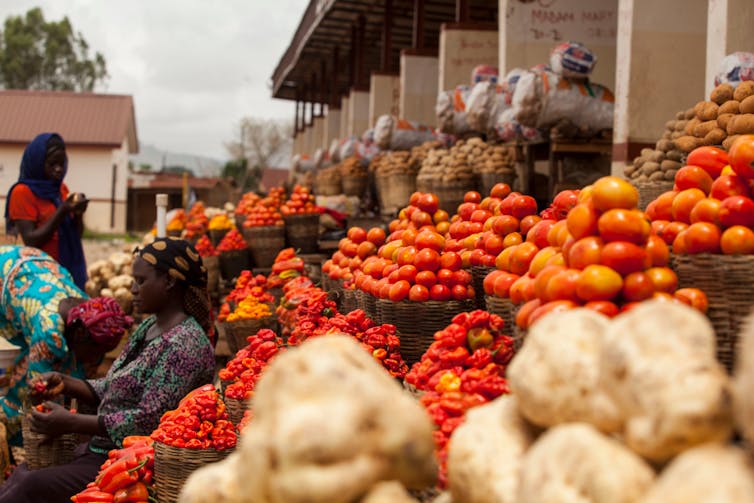
Olayinka Adegbite, University of Pretoria; Elizabeth Mkandawire, University of Pretoria, and Lepepeule Machethe, University of Pretoria
Women smallholder farmers in Nigeria are involved in all aspects of agriculture. This ranges from producing food on farms to putting it on plates. They’re involved in planting crops, livestock production, harvesting, marketing and processing of farm produce as well as food preparation and family care.
Yet, because they are women, they are held back by unequal access to resources – especially finances – that would help make them become more successful.
Agriculture contributes significantly to Nigeria’s economy. It is also the largest employment provider, with female smallholder farmers making up almost half the number of agricultural workers. They also play an important role in aspects of sustainable development. This includes being a bulwark against hunger and poverty in rural areas. Yet the majority still struggle to access affordable financial services to help them develop their farming operations and livelihoods.
Nigeria has made progress in strengthening regulations to enhance financial inclusion. But our study found that these regulations aren’t as effective as they could be to transform agriculture.
In the study, we looked at the gender gap in access to finance among smallholder farmers in Nigeria. And the impact of this on sustainable development.
Our research showed that these women farmers tended not to have bank accounts. This meant they lacked access to financial services like savings, credit and transactions.
This gender gap needs to be closed. We propose that this be done by introducing policies that favour women farmers. This could include targets for financial inclusion. It could also include implementing policies through collaboration with public organisations, the private sector and civil society.
Including women smallholders
Financial inclusion is meant to ensure all people have equal opportunity to access and use affordable financial services. These services include savings, credits, insurance, payments, transfers and remittances.
It’s been shown to have very positive effects on the lives of poor people. In addition, financial inclusion and achieving gender equality has been shown to have a positive influence on sustainable development.
Yet, the plight of women smallholders is often ignored by policy makers, financial institutions and those working in the agricultural sector.
Our study found that a significant financial inclusion gender gap exists in Nigeria’s smallholder agriculture. The largest gender gaps were in formal account ownership and savings. In other words fewer women farmers had accounts and saved with bank financial institutions, non-bank or mobile money service providers.
Also, fewer women smallholders owned mobile phones compared to men. As mobile banking is growing in Nigeria, not having a mobile phone means that women are excluded.
Other factors contributing to women’s financial exclusion include: poverty, low levels of literacy, limited education and limited assets. In addition, because of cultural and patrilineal traditions women typically don’t own land. They also have limited decision making powers when it comes to money.
Other restrictions include the fact that most women are constrained from participation in the marketing of high value crops. And then there’s institutional discrimination. An example is when financial institutions require a male signatory to grant a formal loan to a female farmer.
Need for financial inclusion
Nigeria tabled a revised national financial inclusion strategy in 2018. It identified the need to address gender gaps in financial inclusion. But no key performance indicator was set for women in smallholder agriculture.
Our study suggests this is a major omission. Failure to address the causes of women’s financial exclusion in Nigeria’s smallholder agriculture could result in a network of negative consequences. For example, the financial inability to adopt modern technologies – or access information – increases vulnerability on a number of fronts. This includes climate change, food insecurity and malnutrition, all while the population is increasing.
In turn, this degenerates into a vicious cycle of income inequality, poverty and poor socioeconomic development. This affects not only the women smallholder farmers, but their children, households, communities and the Nigerian economy.
Recommendations
No single approach can tackle the interrelated causes and effects.
But our study identified the need for Nigeria’s strategy to integrate gender specific goals for financial inclusion in smallholder agriculture. It is also important to establish partnerships between different stakeholders. These would include government, private and non-governmental organisations that have a common interest in women smallholders’ access to finance. Such partnerships should implement and finance clear-cut strategies in bridging financial inclusion gender gaps in smallholder agriculture in Nigeria.
Approaches should include developing agricultural finance innovations that reflect the realities of women. They need to be affordable, based on the financial needs of farmers. For example financial institutions should come up with and accept options – apart from land – that can be used as collateral for women smallholder farmers.
Similarly, successful models like the Nigerian Incentive-Based Risk-Sharing System for Agricultural Lending should integrate and empower women smallholders in their agricultural value chain financing models.
Finally, it is important that Nigeria’s financial literacy agenda extend to smallholders and rural areas. And there should be systemic efforts at all level of society to ensure that women have direct access to finance and control.![]()
Olayinka Adegbite, PhD candidate, University of Pretoria; Elizabeth Mkandawire, Postdoctoral Fellow and Coordinator: UN Academic Impact Hub for SDG2, University of Pretoria, and Lepepeule Machethe, Professor of Agricultural Economics, University of Pretoria
This article is republished from The Conversation under a Creative Commons license. Read the original article.

